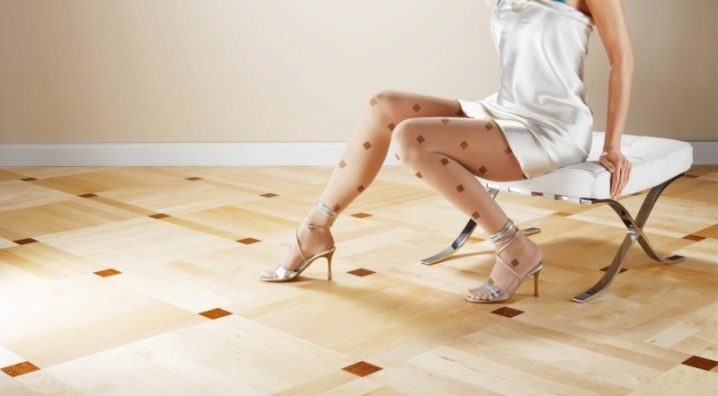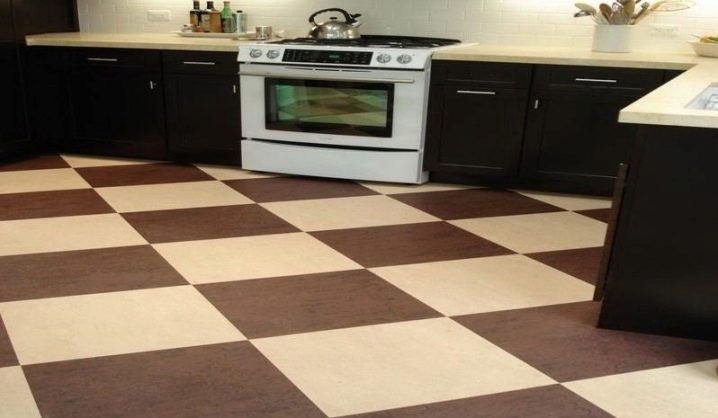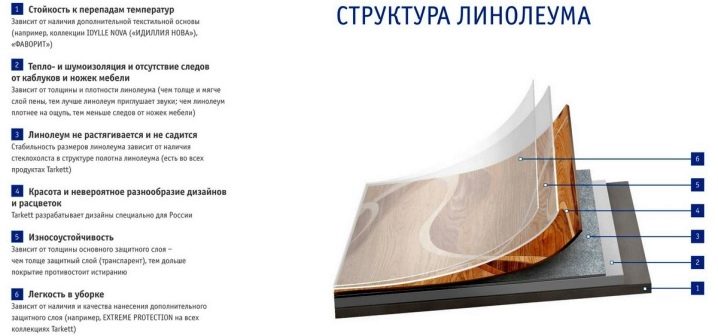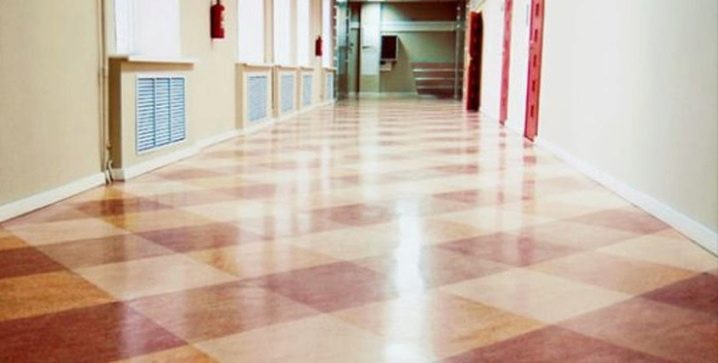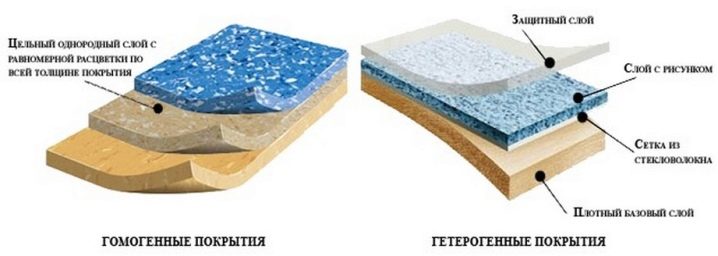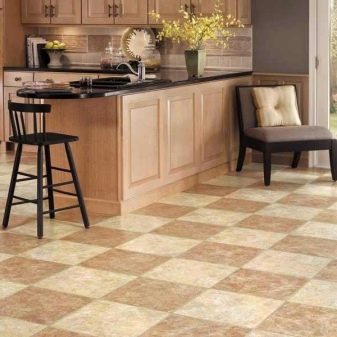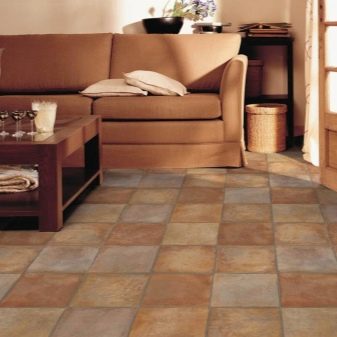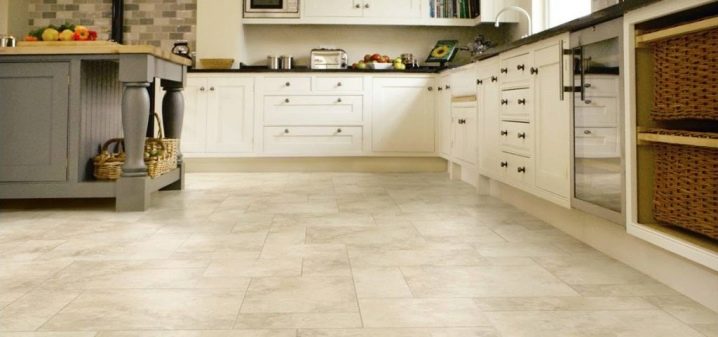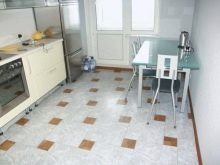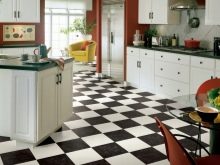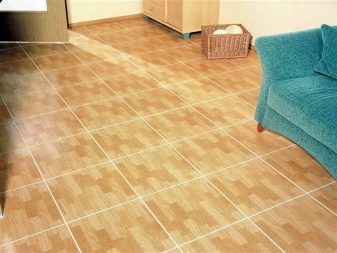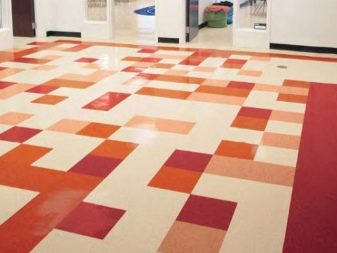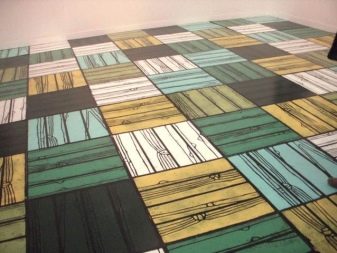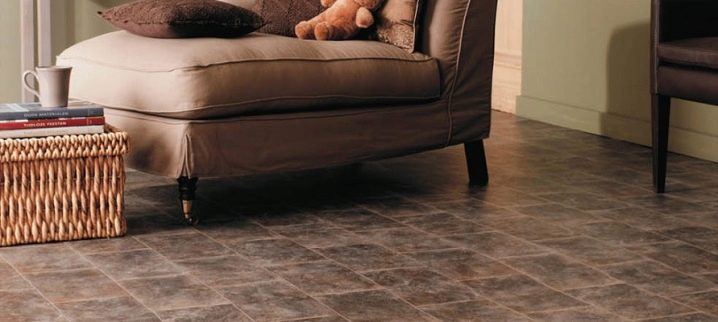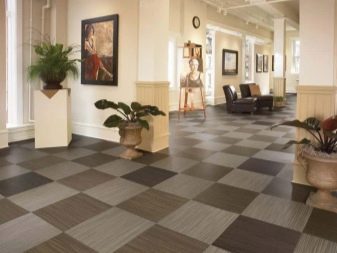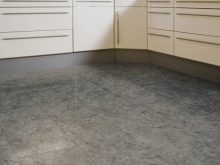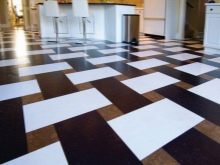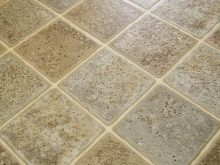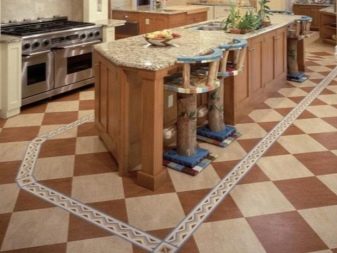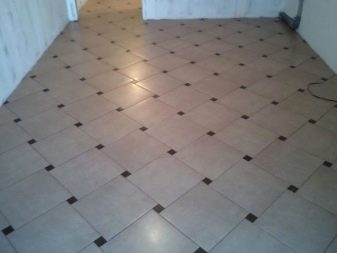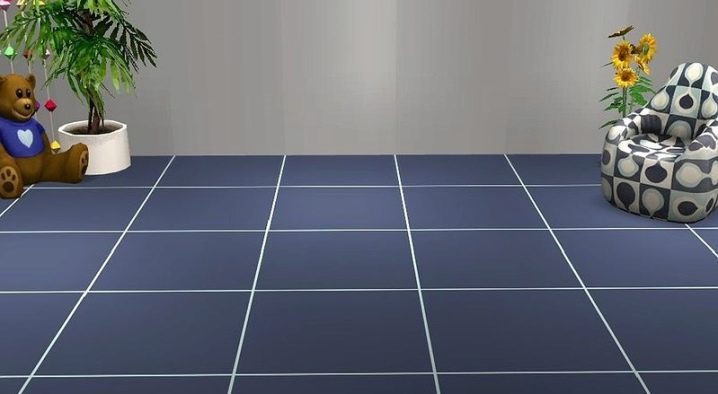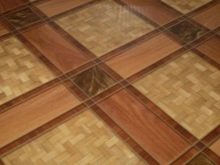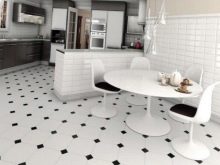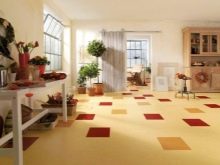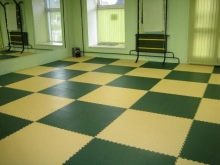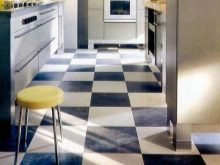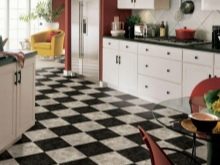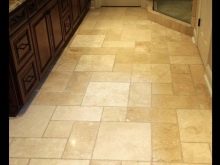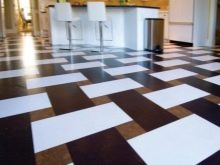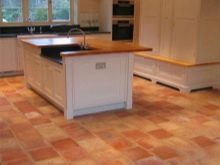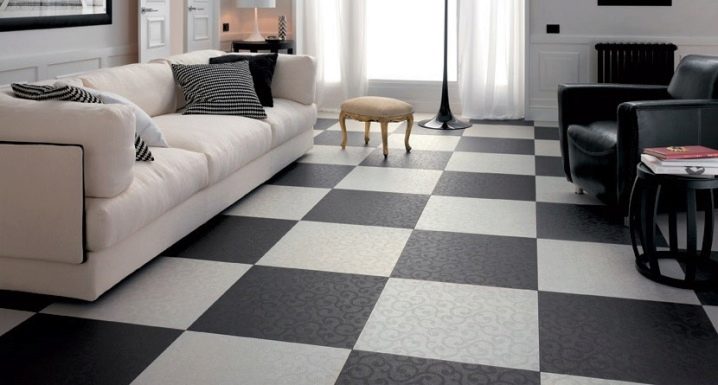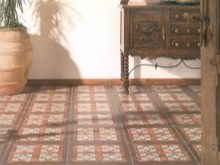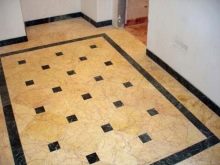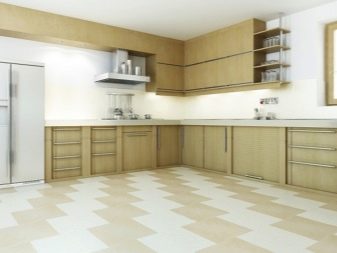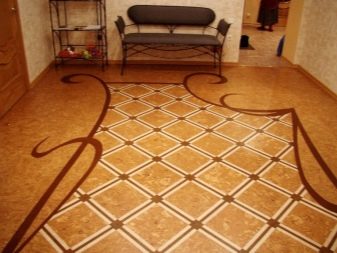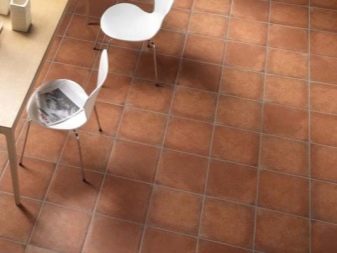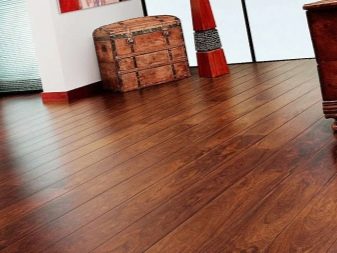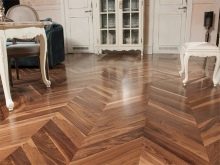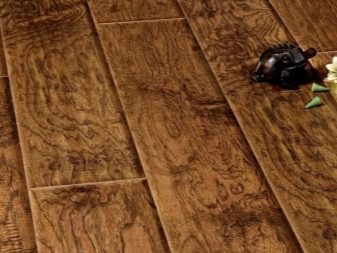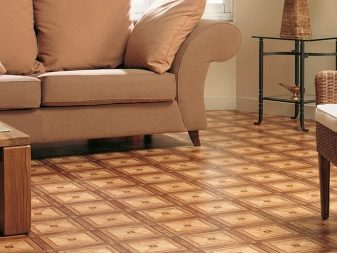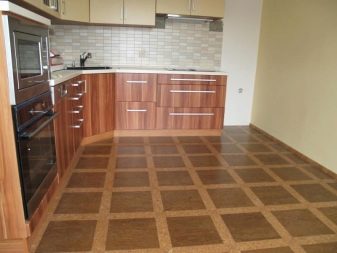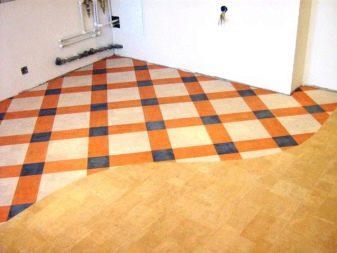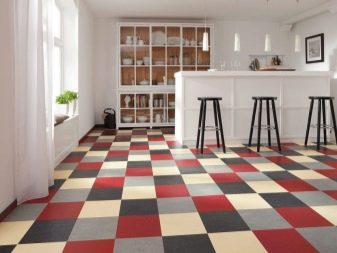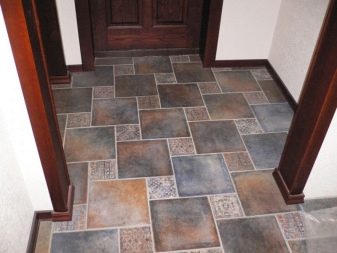Linoleum under the tile

Linoleum tile is an original interior solution that provides different design possibilities. It is known to many, although today its structure and form differs from the variants of past years.
Linoleum under the tile is a unique floor covering material, has a lot of advantages and stands out against other analogues.
Kinds
Linoleum tile - facing materials, which are made of polymeric materials and in comparison with ceramic tiles have several advantages. The material has a softer type of surface and warmth in contact, it is safe for health. This is linoleum, the coloring of which is similar to tiled masonry or a variety in the form of fragments.
The material itself is quite durable: this is due to the updating of the structure, which consists of several layers:
- base bottom of PVC;
- balance of glass fiber reinforced PVC;
- a layer of PVC base, having an additive in the form of quartz sand;
- decorative layer with a print;
- Protective polyurethane coating with anti-slip, embossed, UV protected.
Layering - the main reason for the high quality characteristics of linoleum under the tile. Due to it, linoleum is able to withstand standard weight loads, without disturbing the structure of the surface, featuring excellent elasticity and flexibility. The polyurethane coating provides the fabric with protection against wear, mechanical damage, bursting, burning out in the sun, and if it has a special additive, it prevents sliding on the surface of the coating.
Types of linoleum are divided into three types:
- household - for rooms with small and low traffic;
- semi-commercial - a kind for residential premises with an average maneuverability;
- Commercial - an option for offices and shops where the floor is exposed to a maximum weight load every day.
The first option is a budget line of existing varieties, tiled linoleum semi-commercial type - the standard for apartments, this is a version with high levels of resistance to exploitation. Commerce is a premium flooring type.
The difference between the three types of linoleum is actually simpler than the sellers say. It is visible externally: for this you need to look at the cut of linoleum from the side. Upon closer examination, you can notice the protective layer formed by the polymerization of liquid polyurethane, and the foamed or felt base.
It is worth remembering that the thicker the protection, the higher the class of linoleum and the thinner the base layer:
- if the protective layer is practically invisible, and the thickness of the web fluctuates up to 4 - 5 mm, this is a household option;
- when the rough top layer is 0.2–0.3 mm, and the base is noticeably smaller, this semi-commercial type linoleum;
- if the top layer of protection is well defined and reaches 0.6 mm, while the thickness of the web is very small - this is the highest class (commercial).
If you need a quality option, it is worth choosing between the second two. However, it is worth considering: the thin base of commercial linoleum will demonstrate all the irregularities of the floor, if it is laid on concrete.In this case, the thickness of the protective layer will not save the situation; however, it may help substrate, which will hide the defects of the concrete floor and warm the surface floor covering. It is important to remember the small rule of the flooring with the substrate: if the base of linoleum is foamed, the substrate is appropriate. .
Felt base does not need this addition, since it itself performs its function
Linoleum tile has a lot of advantages, it:
- combines the quality indicators of the best varieties of linoleum and the appearance of ceramic tiles, easy to lay;
- significantly cheaper than the ceramic counterpart, so the installation will fit into the planned budget;
- is a versatile floor covering appropriate in different types of rooms (living room, nursery, kitchen, study, library, loggia, corridor, hallway, bathroom);
- easy to clean, resistant to moisture, detergents and some chemicals to remove stains;
- fire-resistant, even if it ignites, the percentage of harmful substances released into the air of the material will be minimal;
- shock resistant, not subject to temperature extremes, although in rolled varieties when heated by means of a hair dryer or iron, it may slightly change in size;
- depending on the model it is combined with the “warm floor” system, it may contain raw materials of natural origin;
- it has a wide range of color palettes, allowing you to harmoniously fit the floor covering into the conceived design idea;
- differs in the different sizes that allows to carry out a flooring with a minimum of joints or at all without them;
- based on the premium class, differs in different cost, allowing each customer to decide on the most suitable option for the wallet and taste.
Linoleum under the tile is convenient because it is easy to replace if desired, while removing ceramic tiles from the floor without disturbing the concrete layer will be problematic. It does not create an environment for the appearance of microorganisms, so there will be no mold or fungus under it. This material provides excellent sound insulation.
The cons of linoleum under the tile leads to the fact that not every type of such coating is worth buying:
- budget models can not withstand a lot of weight;
- options with colorful ornaments are limited in placement (not suitable for rooms overloaded with a mass of elements of furniture);
- products with a large pattern can visually reduce the space of the room;
- not always models of fragments coincide in shade, which violates the integrity of the floor covering;
- Not every type of raw material is good for bathrooms, as it does not have a “breathing” structure;
- not all canvases have a special impregnation that ensures safety;
- Laying does not tolerate haste and carelessness: the result in the form of inconsistencies and skewed pattern will be evident.
Vinyl Linoleum Tiles
Linoleum in the form of individual fragments - a separate line of floor coverings, which by strength exceeds the roll analogs. It is easier to install, does not form waves, allows you to simplify the process of laying linoleum squares on the floor. Fragments of this material are small, their docking does not cause difficulties. Externally, this material is a square (rarely strips) of linoleum, which are glued to the floor surface with a special glue, performing the marking in advance, taking into account the pattern.
The disadvantage of this raw material can be called susceptibility to the formation of dents due to the long stay of objects on the surface of the floor covering. The choice of such material must be solid: not all that is offered for sale, is of high quality. Cheap raw materials have low polyurethane protection, which does not provide the coating with the preservation of saturated surface tones in the proper volume. If you really want to lay such material on the floor, you should make a purchase in a proven store with a good reputation.
And you need to buy expensive goods, the cost of which is close to the laminate.
Features of the invoice
The surface of the material is unique and can be:
- matte;
- glossy;
- rough;
- smooth
- with little relief.
The relief of the paintings forms an imitation of the grouting joints, which are carried out when laying tile. Unlike ceramics, they are not weak places of linoleum, do not complicate care of it. Some types of material are difficult to distinguish from tiled raw materials - this linoleum looks so professional.
In addition to the seams, relief texture can be a pattern on certain fragments of paintings. Most often it is not large, it is simple and does not weigh down the general background of the future sex.
Tips for choosing
The choice of beautiful linoleum under the tile is a creative and interesting task. To buy the right option, it is worth taking note Some expert tips:
- the larger the size, the fewer problems with joints and flooring in general;
- for the kitchen is suitable semi-commercial type material under the tile 30x30 cm;
- the color of the picture should not be dark or excessively bright: this is how the interior is overloaded;
- drawing from different canvases should be from the same batch;
- too strong smell indicates poor quality of the material;
- thin linoleum is suitable for laying on fiberboard, self-leveling floor;
- Certificate of quality and safety standards - a mandatory condition for the purchase;
- choosing a rolled type of material, it is worth taking care of the width in order to lay a one-piece piece on the floor without joints.
Colors and colors
The color solutions of linoleum for tiles are varied, depending on the preferences and the conceived idea of the design. The modern market for such products offers a lot of variations of color combinations or plain tiles that will find a buyer. Linoleum, imitating different surfaces - an excellent design technique,which indicates the status of the situation and the subtle taste of the owners of the house.
The most popular shades of linoleum tile are:
- white;
- beige;
- yellow;
- green;
- Navy blue;
- the black;
- sand;
- gray blue;
- terracotta;
- brown.
Tones can be combined with each other. This can be a canvas in neutral or cold colors (black and white, the combination of white and gray shades, gray-blue and dark blue with imitation of white seams).
The main thing is that the coloring should have a light tone: a light floor will create the illusion of space and add light to the room without restricting space.
Picture
The pattern of tiled fragments is diverse: each square can be:
- mosaic with a different arrangement of microparticles;
- four squares with a small rhombus in the center;
- square with bricks around;
- diagonal laying of two sizes;
- part of the overall ornament.
The most interesting design techniques that change the aesthetic perception of the situation are the options for:
- classic ceramic tiles;
- imitation of natural wood;
- marble;
- laminate;
- crocodile skin.
Modern technologies allow us to give the canvas different ornaments,using photo printing. The range of patterns is constantly updated, so you can even find a non-standard solution. A unique technique is the involvement in the colors of several shades of the same range. This creates an illusion of the volume of linoleum tile, giving the flooring a carpet-like look.
On such tiles, plant ornaments and stylized compositions with symmetrical repetition are often visible.
Variants of placement in the interior
To the placement of tiled linoleum in the interior was harmonious, it looked beautiful and did not violate the overall picture of the situation, you can pay attention to several options for the layout of the floor covering with interior items:
- Linoleum in the form of fragments of different sizes is appropriate in a spacious beige-colored kitchen, if its texture is similar to the countertops of the furniture and the tile of the apron, it coincides with them in shade;
- the shade of the canvas may differ slightly from the main accent - furniture, but in this case it is important that it be chosen in the same range with it;
- if the interior is replete with light, the linoleum tile in the contrast of beige, gray and wine shades will help bring harmony to the interior: made in the style of minimalism, it will bring brightness and creativity to the room, filling it with bright spots;
- Linoleum under the tile in the style of country, having a pattern in the form of small colors, is appropriate in the interior of the sunny kitchen: having support for the shades of the walls and furniture, it looks stylish and homely;
- if there are a lot of dark colors in the room, tiled linoleum with geometric patterns in light neutral colors can save the situation, having support in the form of furniture and decorative design elements (for example, dishes);
- for the corridor the tile linoleum of gray and brown shades is good: it will emphasize the premium nature of the doors and doorways.
On how to properly lay the linoleum in the house, you can learn in the next video.
